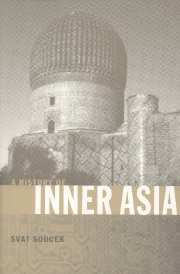Book contents
- Frontmatter
- Contents
- List of maps
- Preface
- Introduction
- 1 The beginnings
- 2 The Kök Turks, the Chinese expansion, and the Arab conquest
- 3 The Samanids
- 4 The Uighur kingdom of Qocho
- 5 The Qarakhanids
- 6 Seljukids and Ghaznavids
- 7 The conquering Mongols
- 8 The Chaghatayids
- 9 Timur and the Timurids
- 10 The last Timurids and the first Uzbeks
- 11 The Shaybanids
- 12 The rise of Russia, the fall of the Golden Horde, and the resilient Chaghatayids
- 13 The Buddhist Mongols
- 14 Bukhara, Khiva, and Khoqand in the seventeenth to nineteenth centuries
- 15 The Russian conquest and rule of Central Asia
- 16 From Governorates-General to Union Republics
- 17 Soviet Central Asia
- 18 Central Asia becomes independent
- 19 Sinkiang as part of China
- 20 Independent Central Asian Republics
- 21 The Republic of Mongolia
- Summary and conclusion
- Appendix 1 Dynastic tables
- Appendix 2 Country data
- Select bibliography
- Index
21 - The Republic of Mongolia
Published online by Cambridge University Press: 05 June 2012
- Frontmatter
- Contents
- List of maps
- Preface
- Introduction
- 1 The beginnings
- 2 The Kök Turks, the Chinese expansion, and the Arab conquest
- 3 The Samanids
- 4 The Uighur kingdom of Qocho
- 5 The Qarakhanids
- 6 Seljukids and Ghaznavids
- 7 The conquering Mongols
- 8 The Chaghatayids
- 9 Timur and the Timurids
- 10 The last Timurids and the first Uzbeks
- 11 The Shaybanids
- 12 The rise of Russia, the fall of the Golden Horde, and the resilient Chaghatayids
- 13 The Buddhist Mongols
- 14 Bukhara, Khiva, and Khoqand in the seventeenth to nineteenth centuries
- 15 The Russian conquest and rule of Central Asia
- 16 From Governorates-General to Union Republics
- 17 Soviet Central Asia
- 18 Central Asia becomes independent
- 19 Sinkiang as part of China
- 20 Independent Central Asian Republics
- 21 The Republic of Mongolia
- Summary and conclusion
- Appendix 1 Dynastic tables
- Appendix 2 Country data
- Select bibliography
- Index
Summary
When the Uzbeks and other Central Asians declared independence in 1991, it was not only a liberation from Russian rule but also from a tyrannical ideology. The significance of the latter dimension is illustrated by the case of Mongolia. This Soviet satellite did not need to declare independence, for it had enjoyed the privilege of being independent since its creation in 1921, if only because it was Moscow's faithful ally not by force but by choice. It did need, however, the latter liberation, and it too attained it thanks to the bloodless revolution unwittingly unleashed by Mikhail Gorbachev.
The Communist system, which had initially wrought transformations beneficial to Mongolia, had begun to stagnate in a way similar to its evolution in the Soviet Union; and here the country's status as Russia's mirror image once more brought good dividends when first glasnost and perestroika jumped the border and spread to Mongolia as well, and then again when the collapse of Communism in Russia allowed the Mongols too to shed this straitjacket.
BRIEF HISTORY SINCE 1911
We have related in Chapter 13 how between 1691 and 1911 Mongolia was a personal dependency of the Manchu Dynasty ruling China. Toward the end of that period it also began to be called Outer Mongolia (an appellation somewhat resented by the Mongols themselves), in contrast to Inner Mongolia, the territory along its southeastern border inhabited by Mongols but administratively integrated into China.
- Type
- Chapter
- Information
- A History of Inner Asia , pp. 297 - 302Publisher: Cambridge University PressPrint publication year: 2000

